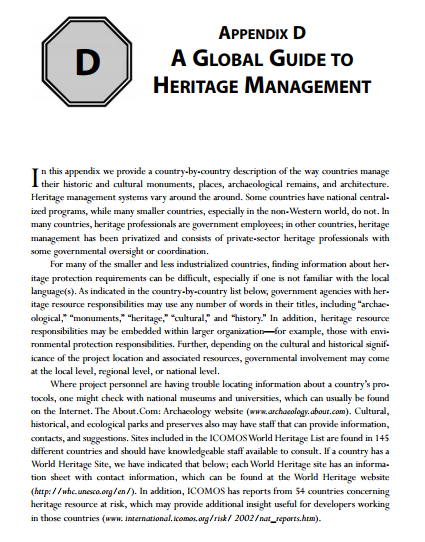Archaeological Disasters
“What was that?” the track hoe operator yelled as he pulled back the bucket. “I don’t know, probably rocks. Keep going, we’ve got to get this done today,” snapped the supervisor. Digging continued, and minutes later, the back dirt pile was littered with wood and rocks, broken pottery, and bones. “You better stop work, Joe; I have to call this in.”
We hear stories like this one time and time again. A construction project stops because of an archaeological discovery. Time stands still while the project proponents, archaeologists, bureaucrats, and concerned groups hold meeting after meeting to decide what to do next. Costs escalate, schedules evaporate, and people become frustrated, angry, and confused.
It doesn’t have to be this way. By following a few basic steps, construction managers, developers, and others can avoid disturbing important heritage resources and turn the situation from a problem to a success.
The book
Darby C. Stapp and Julia G. Longenecker have written a book for project managers, project engineers, construction managers, agency personnel, and archaeological consultants involved in large construction projects. The goal is to provide enough information and enough archaeological perspective to allow the various parties involved in a project to work intelligently with one another. To help manage an archaeological situation, the authors present an approach based on risk management principles common to the engineering and construction industries. The approach is straightforward and not especially costly. The book explains how to incorporate these archaeological risk management principles into your project and provide the necessary tools to perform the assessments. The approach is flexible enough to be applied to almost any project in any location.
Help! I think I'm encountering a disaster!
If you are sensing that a project is becoming an archaeological disaster and you don't know what to do, use our service inquiry form to contact us for a consultation. After reviewing the situation with you we will suggest potential next steps that you can take to avoid any archaeological disasters. If you want us to provide additional assistance, we will suggest actions we could make on your behalf, or assist you in finding another consultant.
Heritage Resource Management Requirements–International Guide
Heritage management systems vary around the world. Some countries have national centralized programs, while many smaller countries, especially in the non-western world, do not. In many countries, heritage professionals are government employees; in many other countries, heritage management has been privatized and consists of private sector heritage professionals with some governmental oversight or coordination.
For many of the smaller and less industrialized countries, finding information about heritage protection requirements can be difficult, especially if one is not familiar with the local language(s). As indicated in our country-by-country list below, government agencies with heritage resource responsibilities may use any number of words in their titles, including “archaeological,” “monuments,” “heritage,” “cultural,” and “history.” In addition, heritage resources responsibilities may be embedded within larger organization, for example those with environmental protection responsibilities. Further, depending on the cultural and historical significance of the project location and associated resources, governmental involvement may come at the local level, regional level or national level.
In the attached guide (right), we provide a country-by-country description of the way countries manage their historic and cultural monuments, places, archaeological remains, and architecture. The information we provide is largely from English-based sources, which limits the number of countries included in this edition. As we find new information, we’ll update the guide. If you have additions or corrections, please send them to darby.stapp@northwestanthropology.com.

